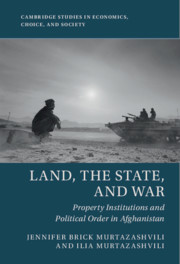Book contents
- Land, the State, and War
- Land, the State, and War
- Copyright page
- Dedication
- Contents
- Photographs and Drawings
- Maps
- Figures
- Tables
- Maps
- Acknowledgments
- Glossary
- Abbreviations
- Chronology of Events
- 1 Introduction
- 2 A Theory of Property Rights
- 3 Property Rights and State Building
- 4 Property Rights and War
- 5 Self-governance of Property Rights
- 6 Self-governance, War, and the Commons
- 7 Self-governance, Legal Titling, and the State
- 8 Are Property Rights a Cause or Consequence of Political Order?
- Appendix
- References
- Index
2 - A Theory of Property Rights
Published online by Cambridge University Press: 20 August 2021
- Land, the State, and War
- Land, the State, and War
- Copyright page
- Dedication
- Contents
- Photographs and Drawings
- Maps
- Figures
- Tables
- Maps
- Acknowledgments
- Glossary
- Abbreviations
- Chronology of Events
- 1 Introduction
- 2 A Theory of Property Rights
- 3 Property Rights and State Building
- 4 Property Rights and War
- 5 Self-governance of Property Rights
- 6 Self-governance, War, and the Commons
- 7 Self-governance, Legal Titling, and the State
- 8 Are Property Rights a Cause or Consequence of Political Order?
- Appendix
- References
- Index
Summary
Chapter 2 presents our theory of property rights. The chapter begins by reviewing the literature on property rights, including all relevant theoretical perspective on the emergence of property rights. In our theory, property rights require definition and enforcement. Unlike political theories of property rights, which view the government as the source of property rights, we recognize that organizations whose authority lies outside the state often have an organizational structure comparable to governments. Unlike existing theories of informal property rights, we highlight that the emergence of self-governing property rights requires overcoming dilemmas like those confronting governments. Thus, states and non-state organizations, such as customary council or a tribe, confront similar challenges in establishing property rights. In our theory, property rights protection is more likely when the organization in question has a monopoly on authority, administrative and enforcement capacity, constraints on organizational decision makers, and decision-making institutions are inclusive. We use the theoretical discussion to clarify situations when property rights to land are provided as a public good, the success of self-governance at securing property rights to land, and when legal titling improves social welfare. The chapter concludes with clear empirical predictions that will guide the empirical studies.
Keywords
- Type
- Chapter
- Information
- Land, the State, and WarProperty Institutions and Political Order in Afghanistan, pp. 23 - 37Publisher: Cambridge University PressPrint publication year: 2021

